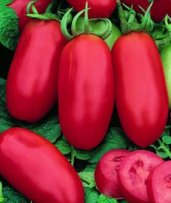San Marzano Tomatoes
Since 2010, Tomato Dirt has garnered 4.8+ million views, making it the web’s leading online source for growing tomatoes in the home garden. Award-winning writer and Tomato Dirt owner Kathy Widenhouse has helped thousands of home gardeners grow healthier tomatoes. Be one of them when you get Tomato Dirt’s Growing Guide here.
San Marzano Tomatoes are a plum tomato variety. They are a household name when it comes to making tomato sauce.
They’re also particularly suitable for preparing peeled tomatoes, canned tomatoes, dried tomatoes, or tomato purée. In fact, skin comes off so easily from San Marzanos that they’re sometimes called, “The King of Peeled.”
They're named for their origin. Certified San Marzano tomatoes are grown in Campania, a region of southern Italy just above the toe of the boot, called Sarnese Agro-Nocerino (Valle del Sarno or valley of the Sarno). Those grown and processed in the valley of Sarno in compliance with Italian law are stamped with “D.O.P.” emblem on the can label.
What does “D.O.P.” mean?
In Italian, D.O.P. stands for "Denominazione di Origine Protetta." The signifies the origin of a product. In this case, it means that the tomatoes in the can are true San Marzanos grown in the valley of the Sarno.
The taste of “genuine” San Marzanos is attributed to the volcanic, rich soil (Mount Vesuvius is in the area) and the Mediterranean climate. Because of their origins near Naples, they’ve been designated as the only tomatoes that can be used for true Neapolitan pizza (”vera pizza Napoletana”.) Aficionados say they can discriminate between San Marzanos grown in the valley and other San Marzanos grown elsewhere.
“Can I grow San Marzanos even if I don’t live in southern Italy?”
Sure. While some devotees (enthusiasts, fanatics …) say that nothing can replace the taste of a San Marzano grown in its home soil, nevertheless gardeners the world over grow this variety with unbridled enthusiasm.
The myth about San Marzanos
There’s a popular myth floating around that the first San Marzano seeds were a gift from the King of Peru to the King of Naples in the 1770s.
But it’s hard to prove and likely not true because:
- San Marzanos aren’t green. The first Peruvian tomatoes were little green fruit, not luscious, bright red plum tomatoes.
- San Marzanos aren’t yellow. When the tomato was introduced to Europe in the mid-1500s, it was called “the golden apple.” Meaning those varieties were likely yellow, rather than green or red.
- Peru had no king in the 1770s. Oops. Since there was no King of Peru in the 1770s (Peru was still staunchly under Spanish control), he could not have given a gift of plum tomato seeds to the King of Naples.
(Get San Marzano Tomato seeds.)
A history of San Marzanos
 |
Photo: Reimer Seeds |
1875: the first cannery in the Campania region was built to pick, peel, pack, and ship San Marzanos across Italy
1894: first known documentation for San Marzanos in the USDA Book of Agriculture, where they were recorded to be large enough to be machine-harvested
1902: San Marzanos are listed on documents of an Italian packer and exporter
1920s-1930s: San Marzano seeds are in German, French, and Italian seed catalogs
1970s: San Marzano popularity plummets as new, more resistant hybrid plum tomatoes are developed and marketed
1990s: Interest in the San Marzano resurges
1996: San Marzano tomato in the Agro Sarnese Nocerino (valley of the Sarno) region of Campania is granted Protected Designation of Origin status
(Get San Marzano Tomato seeds.)
What’s the difference between San Marzano tomatoes and Roma tomatoes?
San Marzanos have a long European history. Varieties range from heirlooms to open pollinated to newly-minted San Marzano hybrids.
Romas, the quintessential American paste tomato, are a hybrid. They were bred in the 1950s to create a tomato with these combined qualities: paste tomato, determinate, plum shape, resistant to fusarium and resistant to cracking.
When it comes to shape, San Marzanos are thinner and pointier than Romas. But both are extremely popular among gardeners for making tomato sauce and for drying. San Marzanos have thicker flesh, fewer seeds, and a taste that’s stronger, more sweet and less acidic than Romas.
San Marzano Varieties
There are more than a couple dozen different San Marzano varieties floating out there. The most popular for the home gardener are:
San Marzano Tomato
San Marzano Redorta. From Tuscany, but named for a mountain much further north (Pizzo Redorta), the Redorta is one of the larger San Marzanos. It’s tasty enough to be eaten off the vine.
Super San Marzano Tomato: an oversized version
| San Marzano Tomatoes |
|---|
| Indeterminate |
| Type: varieties range from heirlooms to open pollinated and hybrids |
| Origin: Europe,17th century |
| Days to maturity: 78-85 days |
| Season: Mid-season |
| Foliage/habit: compact |
| Fruit color: bright red |
| Fruit shape/size: oblong and cylindrical, about 1 inch wide; length ranges 2-5 inches, depending on variety |
| Resistance: cracking |
| Yield: good |
| Taste: sweet, mild, low acidity |
| Other strains: More than two dozen strains. |
| Other notes: San Marzano Tomatoes have developed a well-deserved reputation as a tomato of choice for sauce, paste, and drying. They are meaty and have very few seeds. |
More Tomatoes of the Month
Tomato of the Month: fun and interesting tomatoes ...
Amish Paste Tomato ...
Anna Russian Tomato ...
Better Boy Tomato ...
Brandywine Tomato ...
Celebrity Tomatoes ...
Early Girl Tomato ...
Fourth of July Tomato ...
Green Zebra Tomato ...
Mortgage Lifter Tomato ...
Purple Haze Tomato ...
Sweet 100 Tomato ...
Yellow Pear Tomato ...
As an Amazon Associate and Rakuten Advertising affiliate I earn from qualifying purchases.
SHARE THIS PAGE:
FREE! 10 Must-Know Tomato Growing Tips: 20-page guide
Get yours here:




New! Comments
Have your say about what you just read! Leave a comment in the box below.